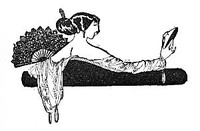The Hohenzollerns in America<br />With the Bolsheviks in Berlin and Other Impossibilities by Stephen Leacock (best memoirs of all time TXT) 📖

- Author: Stephen Leacock
Book online «The Hohenzollerns in America<br />With the Bolsheviks in Berlin and Other Impossibilities by Stephen Leacock (best memoirs of all time TXT) 📖». Author Stephen Leacock
"Oh, Mrs. Putitover, MAY I introduce my very dear old friend, Canon Cutitout? The Canon, Mrs. Putitover, is one of my DEAREST friends. Mrs. Putitover, my dear Canon, is quite one of our most enthusiastic workers."
After which outburst of soul the Bishop is able to add, "Will you excuse me, I'm afraid I simply MUST run."
Personally, I have never known or met a Bishop in society in any other situation than just about to run. Where they run to, I do not know. But I think I understand what they run from.
The Lounge Room of the Club
Equally high in the social scale but done quite differently is the Club Introduction. It is done by a club man who, for the life of him, can't remember the names of either of the two club men whom he is introducing, and who each, for the life of him, can't think of the name of the man they are being introduced by. It runs—
"Oh, I say, I beg your pardon—I thought, of course, you two fellows knew one another perfectly well—let me introduce—urr——wurr——"
Later on, after three whiskey-and-sodas, each of the three finds out the names of the other two, surreptitiously from the hall porter. But it makes no difference. They forget them again anyway. Now let us move up higher, in fact, very high. Let us approach the real thing.
Introduction to H.E. the Viceroy of India, K.C.B., K.C.S.I., S.O.S.
The most exalted form of introduction is seen in the presentation of Mr. Tomkins, American tourist, to H.E. the Viceroy of India. An aide-de-camp in uniform at the foot of a grand staircase shouts, "Mr. Tomkins!" An aide-de-camp at the top (one minute later) calls "Mr. Thompson"; another aide, four feet further on, calls "Mr. Torps."
Then a military secretary, standing close to His Excellency, takes Mr. Tomkins by the neck and bends him down toward the floor and says very clearly and distinctly, "Mr. Torpentine." Then he throws him out by the neck into the crowd beyond and calls for another. The thing is done. Mr. Tomkins wipes the perspiration from his hair with his handkerchief and goes back at full speed to the Hoogli Hotel, Calcutta, eager for stationery to write at once to Ohio and say that he knows the Viceroy.
The Office Introduction, One-sided
This introduction comes into our office, slipping past whoever keeps the door with a packet of books under its arm. It says—
"Ledd me introduze myself. The book proposition vidge I am introduzing is one vidge ve are now pudding on the market..."
Then, of two things, one—
Either a crash of glass is heard as the speaker is hurled through the skylight, or he walks out twenty minutes later, bowing profusely as he goes, and leaving us gazing in remorse at a signed document entitling us to receive the "Masterpieces of American Poetry" in sixty volumes.
On the Stage
Everything on the stage is done far better than in real life. This is true of introductions. There is a warmth, a soul, in the stage introduction not known in the chilly atmosphere of everyday society. Let me quote as an example of a stage introduction the formula used, in the best melodramatic art, in the kitchen-living-room (stove right centre) of the New England farm.
"Neighbour Jephson's son, this is my little gal, as good and sweet a little gal, as mindful of her old father, as you'll find in all New England. Neighbour Jephson's son, she's been my all in all to me, this little gal, since I laid her mother in the ground five Christmases ago—" The speaker is slightly overcome and leans against a cardboard clock for strength: he recovers and goes on—"Hope, this is Neighbour Jephson's son, new back from over the seas, as fine a lad, gal, if he's like the folk that went before him, as ever followed the sea. Hope, your hand. My boy, your hand. See to his comfort, Hope, while I go and read the Good Book a spell in the barnyard."
The Indian Formula
Many people, tired of the empty phrases of society, look back wistfully to the simple direct speech of savage life. Such persons will find useful the usual form of introduction (the shorter form) prevalent among our North American Indians (at least as gathered from the best literary model):
"Friends and comrades who are worthy, See and look with all your eyesight, Listen with your sense of hearing, Gather with your apprehension— Bow your heads, O trees, and hearken. Hush thy rustling, corn, and listen; Turn thine ear and give attention; Ripples of the running water, Pause a moment in your channels— Here I bring you,—Hiawatha."The last line of this can be changed to suit the particular case. It can just as easily read, at the end, "Here is Henry Edward Eastwood," or, "Here is Hal McGiverin, Junior," or anything else. All names fit the sense. That, in fact, was the wonderful art of Longfellow—the sense being independent of the words.
The Platform Introduction
Here is a form of introduction cruelly familiar to those who know it. It is used by the sour-looking villain facetiously called in newspaper reports the "genial chairman" of the meeting. While he is saying it the victim in his little chair on the platform is a target for the eyes of a thousand people who are wondering why he wears odd socks.
"The next speaker, ladies and gentlemen, is one who needs no introduction to this gathering. His name" (here the chairman consults a little card) "is one that has become a household word. His achievements in" (here the chairman looks at his card again, studies it, turns it upside down and adds) "in many directions are familiar to all of you." There is a feeble attempt at applause and the chairman then lifts his hand and says in a plain business-like tone—"Will those of the audience who are leaving kindly step as lightly as possible." He is about to sit down, but then adds as a pleasant afterthought for the speaker to brood over—"I may say, while I am on my feet, that next week our society is to have a REAL treat in hearing—et cetera and so forth—"
II—HOW TO OPEN A CONVERSATION
After the ceremony of introduction is completed the next thing to consider is the proper way to open a conversation. The beginning of conversation is really the hardest part. It is the social equivalent to "going over the top." It may best be studied in the setting and surroundings of the Evening Reception, where people stand upright and agonise, balancing a dish of ice-cream. Here conversation reaches its highest pitch of social importance. One must talk or die. Something may be done to stave it off a little by vigorous eating.





Comments (0)